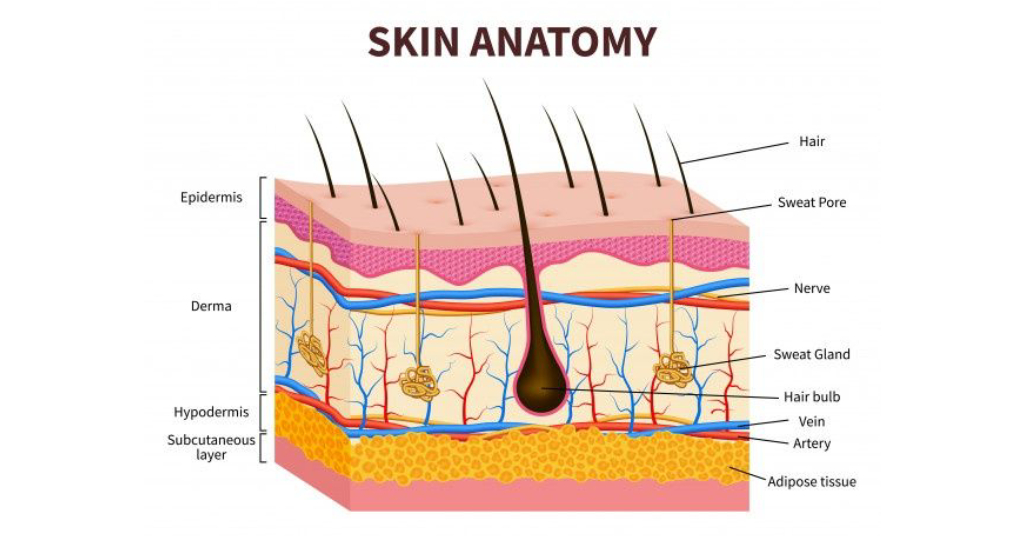
The Top Components Found in Human Skin: A Deep Dive into Our Body’s Largest Organ
The human skin is far more than just a protective outer layer. As the body’s largest organ, it’s a complex structure composed of various elements that contribute to its functionality, resilience, and beauty. Understanding what makes up our skin can provide valuable insights into how it works and how to care for it effectively. Here’s a closer look at the top components found in human skin.
- Keratinocytes: The Building Blocks
Keratinocytes are the most abundant cells in the epidermis, the outermost layer of the skin. They produce keratin, a fibrous protein that provides strength and waterproofing to the skin. These cells play a crucial role in forming the skin’s barrier against environmental damage, pathogens, and dehydration.
- Melanocytes: The Color Controllers
Melanocytes are specialized cells found in the basal layer of the epidermis. They produce melanin, the pigment responsible for skin color. Beyond just giving us our skin tone, melanin also offers protection against harmful UV radiation, reducing the risk of sunburn and skin cancer.
- Collagen: The Support Structure
Collagen is a protein found in the dermis, the middle layer of the skin. It’s responsible for maintaining skin’s structure, firmness, and elasticity. As we age, collagen production decreases, leading to the formation of wrinkles and sagging skin. Skincare products often aim to boost collagen to maintain youthful-looking skin.
- Elastin: The Flexibility Factor
Elastin, another protein found in the dermis, works alongside collagen to give skin its elasticity. This protein allows skin to return to its original shape after stretching or contracting. Over time, elastin fibers can weaken, contributing to the signs of aging like sagging and loss of elasticity.
- Sebum: The Natural Moisturizer
Sebum is an oily substance produced by sebaceous glands located within the skin. It helps to keep the skin hydrated by forming a protective barrier that prevents water loss. Sebum also has antibacterial properties, but an overproduction of sebum can lead to acne.
- Hyaluronic Acid: The Hydration Hero
Hyaluronic acid is a naturally occurring molecule in the skin known for its incredible ability to retain moisture—up to 1,000 times its weight in water. It helps to keep the skin hydrated, plump, and youthful. Hyaluronic acid levels decrease with age, which is why it’s a popular ingredient in anti-aging skincare products.
- Nerve Endings: The Sensation Sensors
The skin is packed with nerve endings, making it a highly sensitive organ. These nerve endings allow us to feel sensations such as touch, temperature, and pain. They play a vital role in protecting the body by enabling us to react quickly to potentially harmful stimuli.
- Langerhans Cells: The Immune Defenders
Langerhans cells are a type of immune cell found in the epidermis. They act as the skin’s first line of defense against pathogens by detecting and capturing harmful invaders like bacteria and viruses. Once these cells identify a threat, they trigger an immune response to protect the body.
- Adipocytes: The Cushion and Insulator
Adipocytes, or fat cells, are found in the subcutaneous layer beneath the dermis. They store energy in the form of fat and provide insulation and cushioning for the skin and underlying tissues. This layer also helps to regulate body temperature.
- Sweat Glands: The Cooling System
Sweat glands are small tubular structures in the skin that produce sweat. This natural cooling system helps regulate body temperature and remove waste products from the body. There are two main types of sweat glands: eccrine glands, which are found all over the body, and apocrine glands, which are concentrated in areas like the armpits.
Conclusion
The human skin is an intricate and multifunctional organ, made up of various cells, proteins, and structures that work together to protect, hydrate, and maintain overall health. Each component plays a unique and vital role in keeping our skin resilient and responsive to the environment. By understanding these elements, we can better appreciate the complexity of our skin and take steps to care for it effectively. Whether you’re focusing on hydration, sun protection, or anti-aging, knowing what your skin is made of can guide you in choosing the right products and treatments to maintain healthy, beautiful skin.
Services we Provide:
| Service Category | Description |
|---|---|
| In-vitro Efficacy Testing | Testing cosmetic products using the RHE tissue model of Episkin to evaluate product claims such as anti-aging, moisturizing, and skin barrier enhancement. |
| Safety Testing | Assessment of skin irritation, corrosion, and sensitization potential using the RHE tissue model of Episkin. |
| Skin Irritation Tests | Evaluating potential skin irritation of cosmetic ingredients and formulations using the RHE model. |
| Skin Corrosion Tests | Determining the corrosive potential of cosmetic products using the RHE tissue model. |
| Barrier Function Tests | Testing the ability of cosmetic products to maintain or enhance skin barrier function with the Episkin model. |
| Photographic Analysis | Capturing high-resolution images of the Episkin model before and after treatment to support efficacy claims visually. |
| Regulatory Compliance Support | Providing data from in-vitro testing with the Episkin model to support regulatory submissions and claims validation. |
